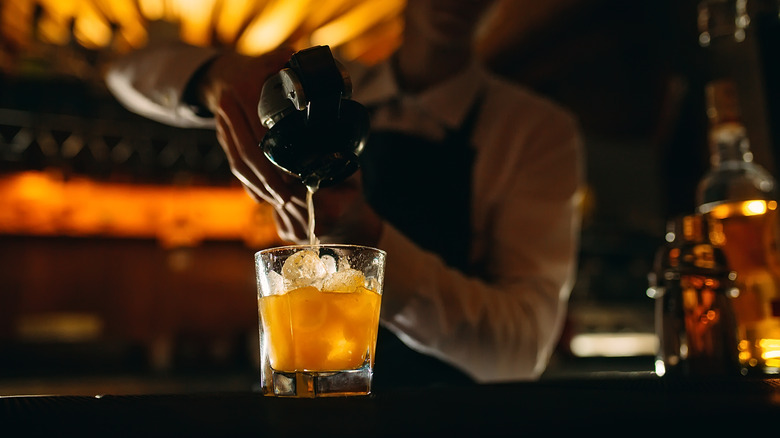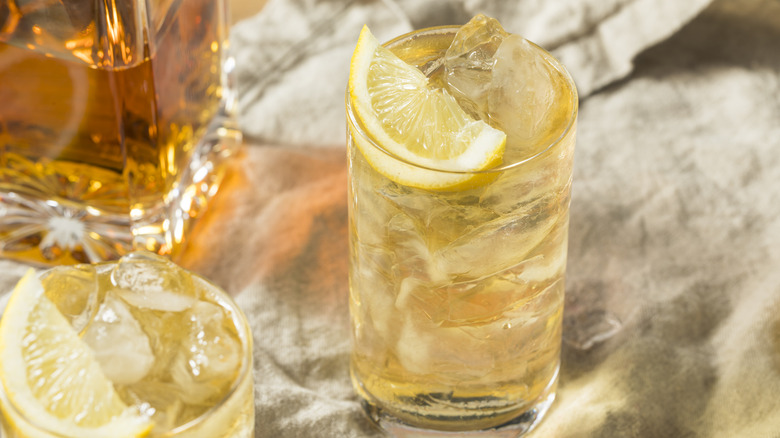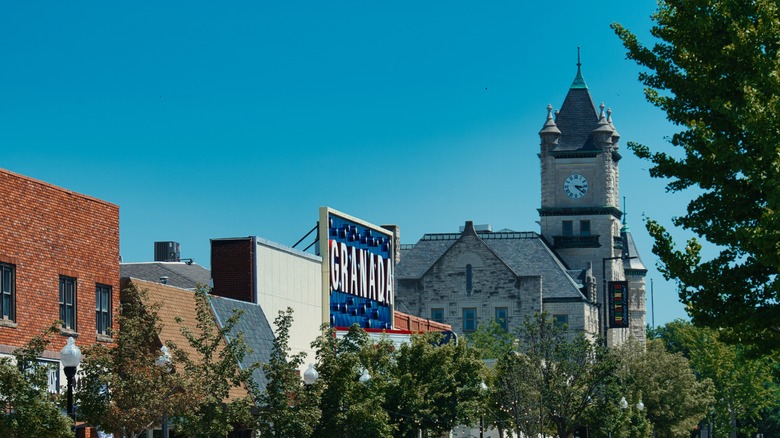Horsefeather: The 'Nonsense' Whiskey Cocktail With Mysterious Origins
Walk into nearly any cocktail bar in America, and the classics will be present — drinks like the Manhattan, old fashioned, and sazerac. All whiskey-based cocktails with pre-20th century origins, their short ingredient list but complex flavor endured for over a century. Now, these beverages are established as icons of American mixology, per Food and Wine. In fact, this period between the 1860s and Prohibition was seen as the Golden Age of American Mixology. In this era, bartenders fine-tuned seemingly simple-to-make but hard-to-perfect recipes.
As newly concocted martinis flowed, some drinks were accredited to specific originators, meticulously collected into recipes by the likes of Jerry Thomas — now known as the father of American cocktail making. However, most appeared out of undefined origins, surrounded by lore and conjectures. While Prohibition altered American mixology forever, notes NPR, such indefinite trajectories of boozy drinks remain. Like the horsefeather — a simple and tasty cocktail surrounded by debate. Let's dive into what this whiskey drink is all about.
What is a horsefeather?
The horsefeather cocktail is a Midwestern riff on the Moscow mule. Rather than the quintessential copper mug, the cocktail favors a highball glass and a whiskey base. In addition to the liquor, the drink comes together with commonplace cabinet staples: Angostura bitters, ginger soda, and lemon or lime slices. It's not hard to make — 2 ounces of whiskey, 4 ounces of ginger beer, a few dashes of bitters, and a spritz of citrus go into a glass with ice. Give it a stir, stick a straw in, and drink quickly before the ice melts, notes Gimme Some Oven.
For a whiskey to honor its origins, mix in J. Rieger & Co. KC Whiskey. However, no need to be strict about the liquor base — any rye or blended whiskey will also provide just the right kind of flavor, notes Midwest Living. Prefer it on the boozy side? Whiskey lovers won't complain if you sneak in more than a shot.
How the horsefeather alludes to Prohibition history
The horsefeather is a newer iteration of classic whiskey-based American cocktails. Likely, the drink is a reinterpretation of the horse's neck. This 19th-century highball-like cocktail contains a similar assortment of ingredients: whiskey, ginger ale, and a single lemon peel twirl central to its name (via Liqour.com). More popular during pre-Prohibition times, the horse's neck first appeared in print in 1895, referencing a non-alcoholic version with simply ginger ale and lemon. Drinkers added a splash of whiskey, turning the mocktail into a full-fledged cocktail, notes Summer Fruit Cup.
The rise and fall of whiskey distillation in Kansas City follows a similar trajectory, also dampened by Prohibition. In the 19th century, three major distillers operated in the city — one of them, J. Rieger & Co, the whiskey base later intertwined with the horsefeather. Known as a boisterous center for nightlife, Kansas City continued to have an active bar scene throughout Prohibition; however, local alcohol producers phased out of popularity until the late 1980s, reports Visit KC. During this time, the newborn horsefeather, a re-imagination of the horse's neck, was born, per Punch.
Origins of the horsefeather cocktail
Evidence points the cocktail arose amidst the bustling nightlife strip on Massachusetts Street in Lawrence, Kansas, precisely during this renaissance period in the late 1980s and early 1990s — but origins are hazy. As a recent invention, the drink only first appeared in print in "The Bartender's Bible" in 1991, but author Gary "Gaz" Regan can't pinpoint its first emergence. Some argue the drink is from Kansas City, especially due to the aforementioned similarity to the horse's neck highball cocktail, via Liqour.com. Add in the fact that distillery J. Rieger & Co. popularized their whiskey for the horsefeather, and more evidence for Kansas City accumulates. However, several Lawrence institutions interlink with the cocktail's popularity. The now-defunct Paradise Cafe is a strong contender; the bar popularized the drink amongst a multitude of bartenders. Add in the fact the horsefeather continues to dominate Lawrence bars, each with its unique riff, and the small city of the plains makes a strong case for its invention. Quite a lot of fanfare for a drink named after the slang term for nonsense, notes Punch.
Although the rivalry continues, one detail is clear –the cocktail is a celebrated stalwart of both Kansas and Missouri, per the New York Times. So if you're in the region, order a round, and if you're at home — simply mix yourself a tasty batch.



